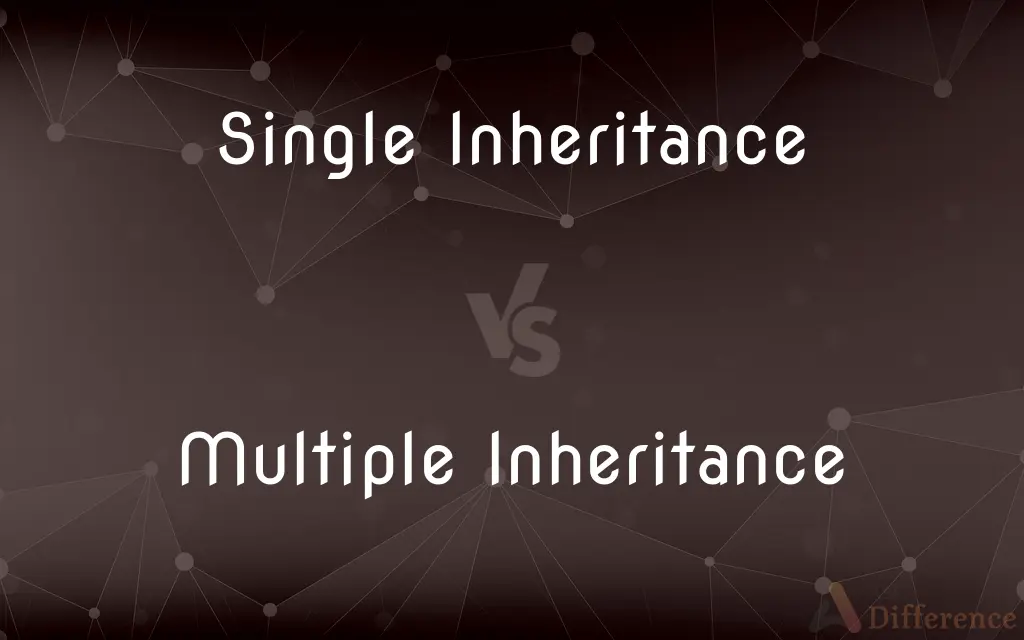Single Inheritance vs. Multiple Inheritance — What's the Difference?
By Tayyaba Rehman & Urooj Arif — Published on February 10, 2024
Single Inheritance is a class inherits from one superclass. Multiple Inheritance is a class inherits from more than one superclass.

Difference Between Single Inheritance and Multiple Inheritance
Table of Contents
ADVERTISEMENT
Key Differences
Single Inheritance involves a derived class inheriting properties and behaviors from a single parent class, creating a linear and straightforward hierarchy. Multiple Inheritance allows a derived class to inherit from multiple parent classes, leading to a more complex hierarchy where a derived class can acquire diverse properties and behaviors from several sources.
In Single Inheritance, the derived class has a clear and direct lineage, making it easier to trace and understand the inheritance path. Conversely, Multiple Inheritance introduces the possibility of a more intricate lineage, as a derived class can have multiple paths leading back to its ancestors, potentially complicating the inheritance structure.
Single Inheritance simplifies the design and maintains consistency since the derived class only extends one parent class. Multiple Inheritance, however, offers greater flexibility but at the cost of potential ambiguity, particularly when different parent classes have methods or properties with the same name.
Single Inheritance is widely supported in many programming languages like Java and C#, ensuring broad compatibility and ease of use. On the other hand, Multiple Inheritance is not universally supported, with languages like Python supporting it but others like Java and C# not, which can influence the choice of programming language for certain projects.
In Single Inheritance, issues like the diamond problem, where a method in the derived class could inherit from multiple sources causing ambiguity, are inherently avoided. In contrast, Multiple Inheritance can lead to the diamond problem, requiring additional mechanisms like Python's method resolution order (MRO) to resolve such conflicts.
ADVERTISEMENT
Comparison Chart
Parent Classes
Inherits from one superclass
Inherits from multiple superclasses
Hierarchy
Linear and simple
Complex and non-linear
Support in Languages
Broadly supported (e.g., Java, C#)
Limited support (e.g., Python, not in Java/C#)
Ambiguity
Less ambiguous
Can be more ambiguous (e.g., diamond problem)
Flexibility
Less flexible in functionality
More flexible with diverse functionalities
Compare with Definitions
Single Inheritance
Single Inheritance forms a straight-line inheritance hierarchy.
In a hierarchy where a SportsCar class extends the Car class, which in turn extends the Vehicle class.
Multiple Inheritance
Multiple Inheritance can lead to ambiguity, like the diamond problem.
If a HybridVehicle class inherits from both ElectricCar and GasolineCar, it may face method ambiguity.
Single Inheritance
Single Inheritance enables a class to inherit features from one parent class.
In Java, a Dog class can inherit from a single Animal class.
Multiple Inheritance
Multiple Inheritance offers flexibility in combining features from multiple classes.
A MultimediaPlayer class inheriting from VideoPlayer and AudioPlayer classes gains combined functionalities.
Single Inheritance
Single Inheritance is universally supported across object-oriented languages.
The Employee class in Java extends the Person class, a common practice in Java.
Multiple Inheritance
Multiple Inheritance introduces complexity in the inheritance hierarchy.
A Smartphone class in Python inheriting from both Camera and Phone classes creates a complex lineage.
Single Inheritance
Single Inheritance avoids the complexities of multiple inheritance.
A SavingsAccount class extends a single Account class, avoiding the complications of multiple sources of methods.
Multiple Inheritance
Multiple Inheritance is not universally supported in programming languages.
Python supports a Researcher class inheriting from Professor and Writer classes, a feature not available in Java or C#.
Single Inheritance
Single Inheritance simplifies tracing the source of methods and properties.
In C#, a Square class inheriting from a Shape class makes it clear where its methods come from.
Multiple Inheritance
Multiple Inheritance allows a class to inherit from more than one class.
In Python, a FlyingCar class can inherit from both Car and Airplane classes.
Common Curiosities
Do all programming languages support Multiple Inheritance?
No, not all languages support it; for example, Java and C# do not, but Python does.
What is Single Inheritance?
Single Inheritance is a mechanism where a class inherits from only one parent class.
Is Single Inheritance simpler than Multiple Inheritance?
Yes, Single Inheritance is generally simpler and more straightforward.
What is Multiple Inheritance?
Multiple Inheritance is a technique where a class inherits from two or more parent classes.
Can Multiple Inheritance lead to complexity?
Yes, Multiple Inheritance can create a more complex and potentially ambiguous hierarchy.
How does Single Inheritance enhance readability?
By having a clear, linear inheritance path, Single Inheritance enhances code readability and maintainability.
What is a common problem with Multiple Inheritance?
The diamond problem is a common issue, where a class inherits the same method from multiple parents.
Does Single Inheritance limit the capabilities of a class?
It limits a class to inherit from only one parent, but this also simplifies the class structure.
Is Single Inheritance widely used in object-oriented programming?
Yes, it's a fundamental concept widely used in languages like Java and C#.
Is Multiple Inheritance common in real-world applications?
It's less common due to its complexity, but it's used in specific cases where it's beneficial.
Can Multiple Inheritance increase flexibility in a program?
Yes, it allows a class to combine features from multiple parent classes, increasing flexibility.
How does Single Inheritance affect the complexity of a program?
It reduces complexity by creating a straightforward hierarchy.
Can Multiple Inheritance cause method name conflicts?
Yes, if multiple parent classes have methods with the same name, it can lead to conflicts.
Can Multiple Inheritance be used to create hybrid functionalities?
Yes, it allows for the combination of functionalities from different parent classes.
Is it easier to debug programs with Single Inheritance?
Generally, yes, because the simpler hierarchy makes it easier to trace and understand the inheritance.
Share Your Discovery

Previous Comparison
USB 1.0 vs. USB 2.0
Next Comparison
Li-ion vs. NiCadAuthor Spotlight
Written by
Tayyaba RehmanTayyaba Rehman is a distinguished writer, currently serving as a primary contributor to askdifference.com. As a researcher in semantics and etymology, Tayyaba's passion for the complexity of languages and their distinctions has found a perfect home on the platform. Tayyaba delves into the intricacies of language, distinguishing between commonly confused words and phrases, thereby providing clarity for readers worldwide.
Co-written by
Urooj ArifUrooj is a skilled content writer at Ask Difference, known for her exceptional ability to simplify complex topics into engaging and informative content. With a passion for research and a flair for clear, concise writing, she consistently delivers articles that resonate with our diverse audience.
















































